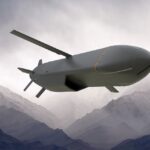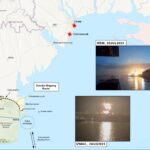The Russian Federation’s military build-up near Ukraine is expanding, drawing forces from the Central Military District and escalating as thousands of snap exercises take place throughout the country.
Social media users have continued to capture scores of rail flatbeds hauling main battle tanks, infantry fighting vehicles, rocket launchers, fuel trucks, and even air defenses.
Sequel to our initial report, here is T-Intell’s breakdown of the most noteworthy open-source information from 2-7 April 2021:
1. Probably the most noteworthy development is the deployment of units from the Central Military District (CMD) towards the Ukrainian border. Russia typically moves and parades units from the Southern Military District and Western Military District if it wants to “bear scare” Ukraine and the West.
However, this week, Conflict Intelligence Team (CITEAM) observed BMPs, MLRS, and other vehicles moving west from Yurga and Novosibirsk (Siberia) on railways.
2/
Yet another video of a train with Russian military vehicles was posted on TikTok on April 2.@666_mancer spotted a carriage number and ran it through “gdevagon” – a railcar tracking databse.
The carriage is travelling from Yurga in Siberia to Voronezh at the border. pic.twitter.com/GiohUIZX4v
— CIT (en) (@CITeam_en) April 4, 2021
Many vehicles’ license plates, which indicate the unit’s origin, have been partially covered to preserve some degree of operations security during the cross-theatre movement.
It is unusual for CMD units to deploy so far from “home” except for strategic exercises. This development sets the recent troop build-up apart from past “bear scares.”
2. Russia ordered all of its forces to conduct readiness inspections. According to the Russian Defense Ministry, a total of 4048 exercises of various scales will take place during April, including 812 bilateral exercises, at 101 training grounds and 520 facilities of the training and material base. Checks will take place in all military districts, and all types and branches of troops will take part in them.
One such snap exercise took place in Opuk training range, Crimean peninsula. Over 200 troops from the 810th Naval Infantry Brigade (Black Sea Fleet) simulated an operation to capture a beachhead. Ground forces assaulted enemy positions using BTR-82s armored personnel carriers and Mi-8AM and Ka-27 helicopters.
3. Enter the battle-hardened “Pskov paratroopers.” Train markings seen in a TikTok video suggest that Russia has instructed one of its most experienced units, the 104th Guards Air Assault Regiment, to join the build-up – CITEAM has found. Based in Cheryokva and part of the 76th Guard Air Assault Division, the 104th is a unit known for having fought and sustained heavy casualties in Eastern Ukraine. The forward-positioning of this echelon adds further credibility to Russia’s build-up.
1/
Long-time Ukraine watchers may remember the Russian 76th Guards Air Assault Division, whose soldiers were killed in Eastern Ukraine in summer 2014.https://t.co/H9KNfI6CnP
Well, they are back — and this time, they are riding a train to Crimea.https://t.co/ocJzHrhhtA pic.twitter.com/4cGpce84fn
— CIT (en) (@CITeam_en) April 5, 2021
4. Advanced air defenses spotted on flatbed railcars, ready for deployment. A video shows a Pantsir S-1 (AFIC/NATO reporting name: SA-22 Greyhound) and numerous S-300 tractor erector launchers (SA-20B Gargoyle) without their missile tubes in an unidentified railway terminal – reportedly Voronezh. This deployment was probably connected with the snap air defense exercise in the Ashuluk training range on 6 April.

Video frame collage showing Pantsir and S-300 systems
5. Russia continues to amass a diverse and increasingly credible posture. The hardware spotted on the move in the past three days include (but are not limited to):
- T-90 main battle tanks (moving from Makhachkala to Crimea);
- T-72 main battle tanks and BMP-3 infantry fight vehicles (Kropotkin train station, Krasnodar);
- 2S4 Tyulpan 240mm self-propelled mortar system (Krasnodar)
- Tunguska anti-air artillery (on the move M1 highway);
- MT-LB armored personnel carriers (Voronezh region);
- Towed howitzer, likely 2A65 Msta-B (Klintsy, Bryansk region);
- 2S23 self-propelled artillery,
- TOS-1 thermobaric rocket launchers (Voronezh region).
6. Despite multiple social media claims, large-scale fighting has not reignited in Donbas. However, there has been a spike in ceasefire violations. The OSCE Special Monitoring Mission (SSM) recorded 1,424 ceasefire violations in the Donetsk region between 2-5 April. In the previous reporting period (2-3 April), the mission recorded 594 ceasefire violations. In Luhansk, the SMM recorded 126 ceasefire violations, a slight decrease from the 427 violations noticed in the previous reporting cycle.

Visualisation of ceasefire violations in Eastern Ukraine © OSCE SSM
In addition, the SSM also noted the disappearance of seven multiple launch rocket systems (BM-21 Grad, 122mm) and five towed howitzers (2A65 Msta-B, 152mm) from a warehouse in the non-government-controlled Luhansk region on 1 April 2021. The report specifically mentions that this is the first time these heavy weapons have disappeared.
7. The Russian-backed “Donetsk People’s Republic” (DPR) has announced military conscription for citizens born 1994 – 2003. Signed on 25 March, the DPR plans to implement the draft between 1 April 2021 and 5 July 2022. Despite the symbolic timing, DPR only expects to mobilize around 200 conscripts. Conscription campaigns are likely to continue and, in time, increase in scope.
#Ukraine: Russian-backed separatist of the Donetsk People’s Republic (DNR) have announced military conscription for citizens born 1994 – 2003. This comes at a time of drastically increased fighting on the frontlines in the Donbas. Not looking good. pic.twitter.com/pwn03I0Cc6
— Jake Hanrahan (@Jake_Hanrahan) April 2, 2021
PRELIMINARY ASSESSMENT
What initially seemed like another annual “bear scare” – Russia’s typical postures ahead of negotiations – has now turned into a credible threat for a renewed offensive against Ukraine. This reading is based on logistical and military indicators that measure capability for an invasion, not the intention – which is political.
Russia’s intentions remain unclear, and our confidence levels for large-scale conventional operations against Ukraine are low to moderate. We maintain our assessment that Russia aims to posture and intimidate. However, given the forces’ heightened readiness and hardware deployed, this can change at any moment.
by HARM
special credits to @GirkinGirkin for aggregating a vast amount of media material from Russian-language accounts
Founder of T-Intelligence. OSINT analyst & instructor, with experience in defense intelligence (private sector), armed conflicts, and geopolitical flashpoints.








